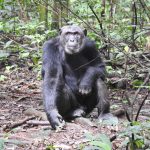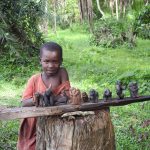Kibale National Park
Traditionally, this dense rainforest has been known as one of the richest primate oases in the world, with up to 13 species. These range from chimpanzees, black-and-white colobus, blue monkeys, grey mangabey, vervets, and red-tailed monkey to – after dark –bushbabies, diminutive galago. Then there is slow-moving pottos, a sloth like primate whose large eyes are quite easily located by torchlight.
Found in Western Uganda, Kibale is a classic, pristine central African forest packed with big mahoganies, towering figs and huge stands of creaking bamboo. This 795km2 wildlife estate is the most visited destination for chimpanzee tracking in East Africa. Why? it has the biggest population density of chimps, over 1,200.
A recent survey has shown that this highland destination further has large mammals like duikers, bushbucks, bush pig and, giant forest hog. Most of these animals can be seen around the marshes on its fourth side where there is a 180km-long forest corridor contiguous with Queen Elizabeth National Park.
From Kibale’s highest point(1,600 metres above sea level), you can see Rwenzori, though it seems elusive. Mostly covered in clouds, you might not actually know it is in the background during your whole stay.
If you have enough time and alot more to spend, the chimpanzee habituation is hard to miss. It is a day-long ‘nest-to-nest’ experience, in which you will track one of the families that are undergoing habituation. During your tour, you will gain intimate insights into their human-like behaviour.
Birdwatching
There is a proposal to turn this park into a UNESCO World Heritage site, and there is a great chance that it will be done within five years time. It really must be preserved as it offers refuge 351 bird species that thrive at climatic conditions of highlands that are 1,500 meters above sea level. Several of these are endemic bird species, inclusive of Blue-headed sunbird, Dusky crimsonwing, Red-faced woodland warbler, Purple-breasted sunbird, Nahan’s francolin. If you are after maximum sightings, a visit to the neighbouring Bigodi wetland is highly recommendable. Among the notables here include Ruwenzori apalis, African pitta, Abyssinian ground thrush, Grey parrot, Red-chested owlet, Blue-breasted kingfisher, Black bee-eater, Scaly-breasted illadopsis, Crowned eagle, Yellow-rumped tinkerbird…the list goes on. Pythons and sitatungas may also be seen at this community protected swamp.
Best time to visit Kibale National Park: The dry season from June to July and December to February




